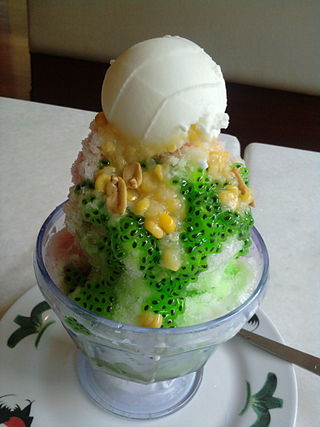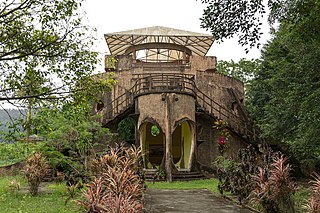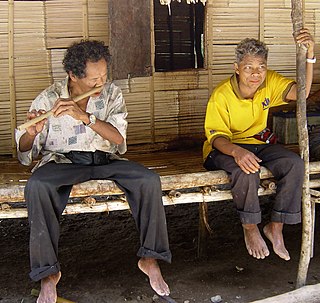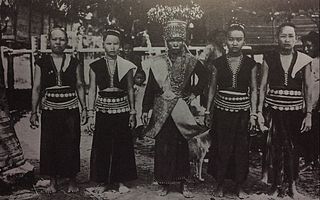
Ais kacang, literally meaning "bean ice", also commonly known as ABC, meaning "mixed ice"), is a Malaysian dessert which is common in Malaysia, Singapore and Brunei.
A national dish is a culinary dish that is strongly associated with a particular country. A dish can be considered a national dish for a variety of reasons:

Dusun is the collective name of an indigenous ethnic group to the Malaysian state of Sabah of North Borneo. Collectively, they form the largest ethnic group in Sabah. The Dusun people have been internationally recognised as indigenous to Borneo since 2004 as per the United Nations Educational, Scientific and Cultural Organization (UNESCO).

The Kadazans are an ethnic group indigenous to the state of Sabah in Malaysia. They are found mainly in Penampang on the west coast of Sabah, the surrounding locales, and various locations in the interior.

Kadazan-Dusun are the largest ethnic group in Sabah, Malaysia, an amalgamation of the closely related indigenous Kadazan and Dusun peoples. They are also known as Mamasok Sabah, meaning "indigenous people of Sabah". Kadazan-Dusun tradition holds that they are the descendants of Nunuk Ragang. Kadazan-Dusun is recognised as an indigenous nation of Borneo with documented heritage by the United Nations Educational, Scientific and Cultural Organization (UNESCO) since 2004. Kadazan-Dusun is part of bumiputera group in Malaysia and has special rights concerning land, rivers, education and maintaining their own customs.

Fried noodles are common throughout East Asia, Southeast Asia and South Asia. Many varieties, cooking styles, and ingredients exist.

Mee rebus, also known as mie rebus/mi rebus in Indonesian spelling, is a Maritime Southeast Asian noodle soup dish. Literally translated as "boiled noodles", it is popular in Maritime Southeast Asian countries such as Indonesia, Malaysia, and Singapore. In Indonesia it is also known as mie kuah, which literally means "noodle soup".

Nunuk Ragang is a site traditionally considered as the location of the original home of the ancestors of the Kadazan-Dusun natives who inhabit most of northern Borneo. The site, nearby a village named Tampias, is located at the intersection of the left and right branches of the Liwagu River to the east of Ranau and Tambunan in Sabah. The two river branches joined up to flow into the Labuk river and drain out into the Sulu Sea. At the site, and under a giant banyan tree, a settlement referred to as Nunuk Ragang was founded. The giant banyan tree was said to be able to give shade to a longhouse sheltering 10 families in it. The legend about Nunuk Ragang had been passed down via oral traditions to the younger generations. No archaeological dig has been carried out to establish the veracity of the legend.

Nasi dagang is a Malaysian dish consisting of rice steamed in coconut milk, fish curry and extra ingredients such as pickled cucumber and carrots.

Kaya toast is a Singaporean dish consisting of two slices of toast with butter and kaya, commonly served alongside coffee and soft-boiled eggs. In Singapore, the dish is traditionally consumed for breakfast, where it has been described as the "quintessential Singaporean breakfast". It became integrated into coffeeshop culture of the country, being widely available in eating establishments such as kopi tiams, hawker centres, food courts and local café chains such as Ya Kun Kaya Toast, Killiney Kopitiam and Breadtalk's Toast Box.
Coastal Kadazan, also known as Dusun Tangara, is a dialect of the Central Dusun as well as a minority language primarily spoken in Sabah, Malaysia. It is the primary dialect spoken by the Kadazan people in the west coast of Sabah especially in the districts of Penampang, Papar and Membakut.
Project IC is the name used in Malaysia to describe the allegation of systematic granting of citizenship to immigrants by giving them identity cards and subsequently its current iteration, the MyKad. The alleged practice is centred in the state of Sabah in East Malaysia. The term is used mainly by the media as well as other political commentators and the general public. Another term used is Project M, the "M" referring to former prime minister Mahathir Mohamad due to his alleged involvement in the spearheading of the project.
Central Dusun, also known as Bunduliwan, is an Austronesian language and one of the more widespread languages spoken by the Dusun peoples of Sabah, Malaysia.

Bruneian Malays are a native Malay ethnic group that lives in Brunei, the federal territory of Labuan, the southwestern coast of Sabah and the northern parts of Sarawak. The Bruneian Malays are a subgroup of the larger ethnic Malay population found in the other parts of the Malay World, namely Peninsular Malaysia and the central and southern areas of Sarawak including neighbouring lands such as Singapore, Indonesia and Southern Thailand, having visible differences especially in language and culture, even though they are ethnically related to each other and follow the teachings of Islam. All Bruneian Malays who are born or domiciled in East Malaysia even for generations before or after the independence of the states of Sabah and Sarawak from the British Empire through the formation of Malaysia in 1963 are also considered Malaysian Malays in the national census and were in the same status like the Malaysian Malays domiciled in Peninsular Malaysian states and the central and southern parts of Sarawak. They are also defined as a part of the Bumiputera racial classification together as a subgroup within the Malaysian Malay ethnic population along with the Kadazan-Dusuns, Orang Ulu, Ibans, Malaccan Portuguese, Muruts, Orang Sungai, Bajau, Suluks and the Malaysian Siamese.

ʻOta ʻika is a Oceanian dish consisting of raw fish marinated in citrus juice and coconut milk. The Tongan, Tahitian, and Samoan variants are essentially identical in that the raw fish is briefly marinated in lemon or lime juice until the surface of the flesh becomes opaque. The fish is then mixed with coconut milk and diced vegetables. This is the national dish of Tonga.

The Orang Asal are the indigenous peoples of Malaysia. The term is Malay for "Original People", used to refer to the aboriginals of Sabah, Sarawak, and Peninsular Malaysia. These groups are given the Bumiputera status in Malaysia.

A Bobohizan or Bobolian is a high priestess, a ritual specialist and a spirit medium in Kadazan-Dusun pagan rites. The office of Bobohizan or Bobolian, is also the chief preserver of Momolianism, i.e. the philosophy and way of life of the Kadazan-Dusun people.

Lihing is a type of Malaysian rice wine that originated from the state of Sabah. It was made from "pulut", a glutinous rice and is a traditional rice wine for the Kadazan-Dusun people. The rice wine is also referred as hiing, kinarung, kinomol, kinopi, linahas, sagantang as well tapai. They are different from one another, but all are made from rice-based drinks. Lihing is sold widely in Sabah including in some major hotels.

Sabahan cuisine is a regional cuisine of Malaysia. As in the rest of Malaysian cuisine, Sabah food is based on staples such as rice with a great variety of other ingredients and different methods of food preparations due to the influence of the state's varied geography and indigenous cultures that were quite distinct from the regional cuisines of the Peninsular Malaysia. Sabah along with its neighbour of Sarawak is famous for their multi-ethnic population.

Sabah is the third most populous state in Malaysia, with a population of 3,418,785 according to the 2020 Malaysian census. It also has the highest non-citizen population, at 810,443. Although Malaysia is one of the least densely populated countries in Asia, Sabah is particularly sparsely populated. Most of the population is concentrated along coastal areas, with towns and urban centers seeing the most population growth.
















